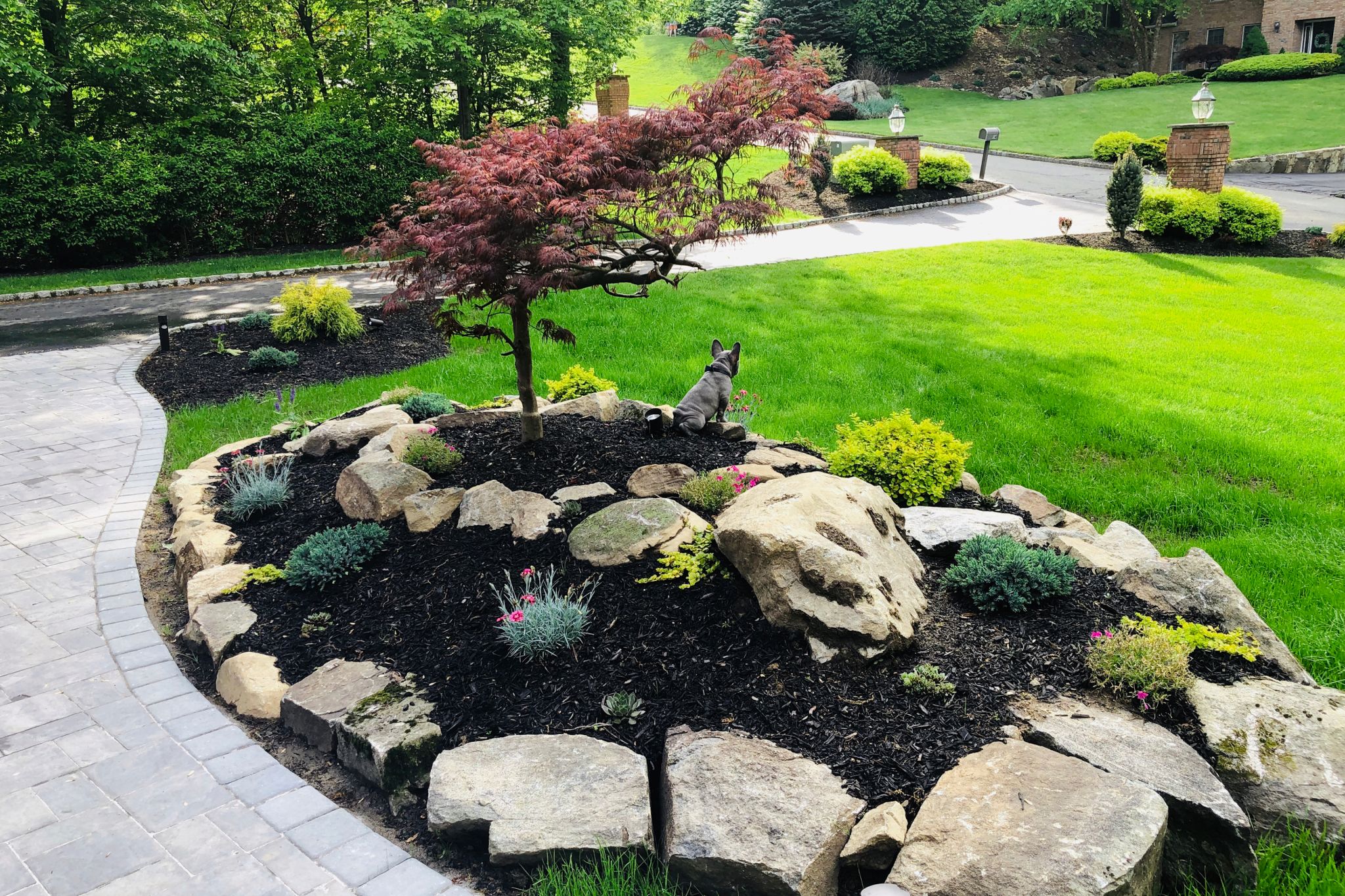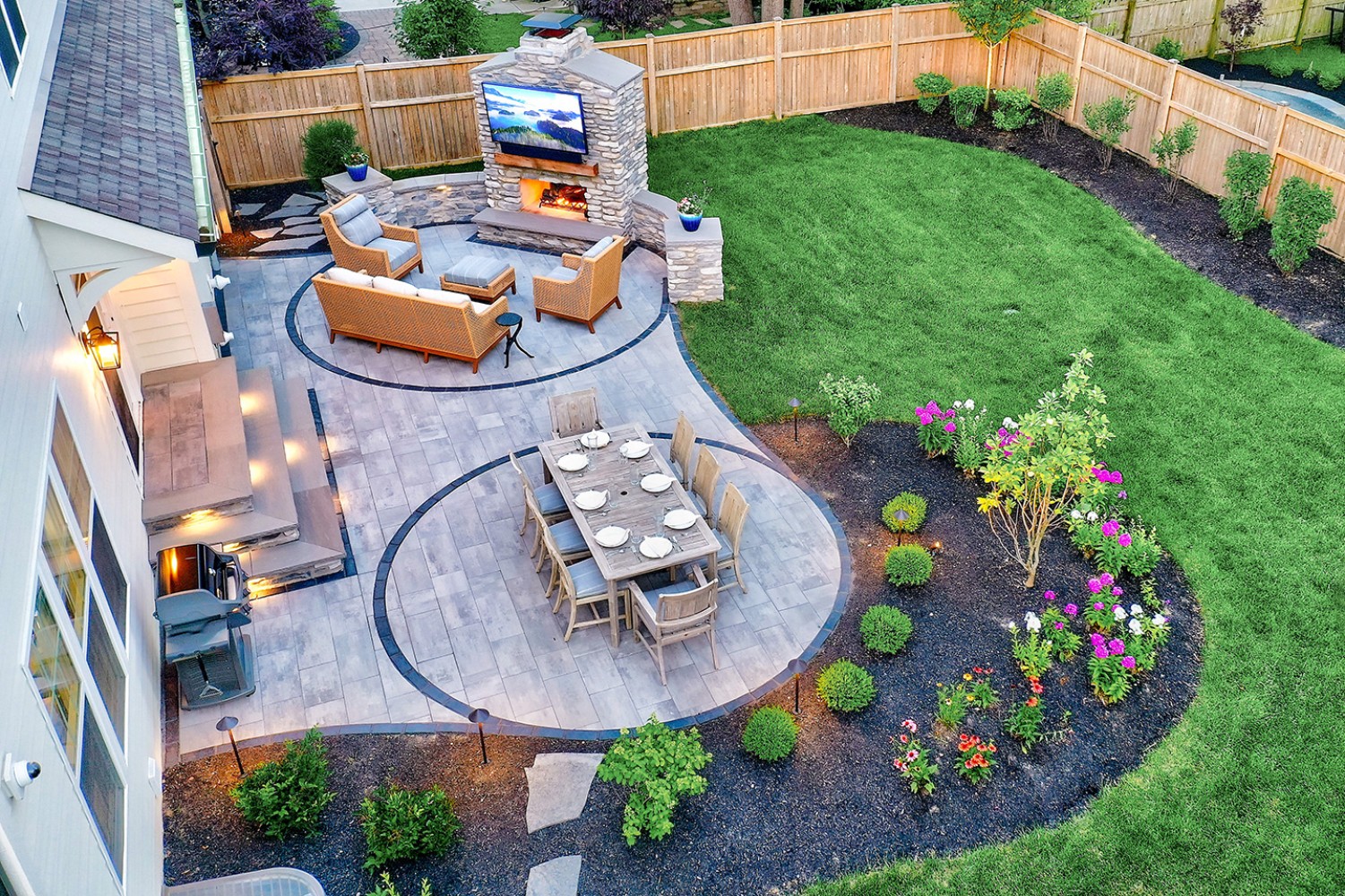Transform Your Garden With Cutting-edge Landscape Design Methods and ideas
Transforming a yard needs thoughtful factor to consider of its one-of-a-kind qualities. Efficient landscape Design can enhance both performance and aesthetic appeal. By exploring numerous methods, one can produce a room that not only shows individual design but likewise sustains regional biodiversity. As the journey unravels, concerns concerning plant choice, sustainability, and design arise, motivating a deeper expedition right into how to make these ideas come to life.
Analyzing Your Outdoor Room: Understanding Your Yard's Potential
Examining outside space is vital for efficient landscape layout. Comprehending the distinct qualities of a garden permits developers to maximize its capacity. Aspects such as soil top quality, sunlight direct exposure, and existing frameworks play a vital function in determining what can be attained. Assessing the topography helps identify locations for growing, paths, or water attributes, while noting drainage patterns assures that plants thrive without waterlogging.
Moreover, acknowledging the yard's microclimates can affect plant selection and positioning. Observing just how the room is used by homeowners informs useful Design choices, such as seating areas or play zones. In addition, thinking about the surrounding environment and neighboring landscapes can supply inspiration and context for Design choices. By extensively taking a look at these components, one can produce a natural and welcoming outside space that mirrors the proprietor's vision while harmonizing with nature. Ultimately, a thorough evaluation prepares for a successful landscape Design project.
Picking the Right Plant Kingdoms: An Overview to Color, Structure, and Seasonal Passion
When selecting plants for a landscape style, comprehending the interaction of color, appearance, and seasonal interest is important for creating a dynamic and vibrant yard. Shade can evoke emotions and established the tone for the area; consequently, picking an unified palette improves aesthetic allure. Warm tones like reds and oranges create energy, while cooler hues like blues and greens use serenity.
Appearance includes depth and measurement, permitting a mix of foliage sizes and shapes. Integrating fine-textured plants with bold-leaved selections develops contrast and intrigue.
Seasonal rate of interest is necessary for preserving year-round charm. Selecting a range of plants that flower in different seasons assurances that the garden remains vibrant, moving from spring's vibrant flowers to fall's abundant foliage. By attentively thinking about these elements, one can curate a landscape that is not only aesthetically pleasing yet also diverse and engaging throughout the year.

Creating Useful Areas: Creating Spaces for Relaxation and Entertainment
Producing functional zones in a landscape Design improves the functionality of outdoor spaces, permitting homeowners to effortlessly blend relaxation and enjoyment. By thoughtfully separating areas into distinct zones, individuals can satisfy various activities, from quiet resorts to lively celebrations. A properly designed space may integrate a cozy reading space snuggled among rich greenery, supplying a serene escape (Landscaper). In contrast, a dynamic exterior eating location can serve as the ideal setting for events with friends and family
Purposefully positioned pathways can direct guests between these areas, ensuring easy navigating. In addition, incorporating components like seating locations, fire pits, or water features can improve the total setting and performance. The integration of varied appearances and shades in each area can produce aesthetic rate of interest while keeping a cohesive aesthetic. Eventually, designing useful zones allows house owners to maximize their outside experience, changing their yards right into flexible rooms that satisfy diverse lifestyle demands.
Including Hardscape Elements: Patios, Walkways, and Focal Points
Including hardscape elements right into landscape Design enhances useful areas by offering framework and visual allure. Patios offer as necessary outdoor home, permitting property owners to delight in dishes and events in a defined area while enhancing accessibility. The selection of products, such as all-natural stone or concrete, can greatly influence the general aesthetic, mixing perfectly with the surrounding environment.
Pathways help with movement through the yard, guiding visitors while adding depth and passion. These courses can be crafted from numerous products, consisting of gravel, pavers, or brick, each contributing to the garden's personality.
Prime focus, such as decorative boulders, sculptures, or water features, draw the eye and develop a sense of objective within the landscape. Purposefully placed, these elements can transform an average garden right into a fascinating space, inviting exploration and interaction. Via thoughtful combination of hardscape, a landscape becomes not only useful but also visually magnificent.
Enhancing Personal Privacy and Protection: All-natural Obstacles and Structures
To improve privacy and protection in landscape layout, making use of all-natural barriers such as thick hedges can properly protect a property from unwanted views. In addition, installing personal privacy fences gives a solid framework that contributes to a sense of security and privacy. Together, these elements produce a more intimate exterior area while discouraging possible breaches.
Planting Thick Hedges
While lots of homeowners seek aesthetic appeal in their landscapes, planting dense hedges serves a double objective of enhancing personal privacy and security. These natural barriers produce an aesthetic shield, successfully blocking the sight from spying eyes and hindering possible burglars. Numerous species, such as boxwood, holly, or privet, can be chosen for their development patterns and foliage thickness, guaranteeing rich coverage throughout the year. In addition, properly maintained hedges can add to a tranquil atmosphere, soaking up sound and giving a habitat for wild animals. The calculated positioning of these hedges can specify property borders and produce private exterior spaces, enabling property owners to enjoy their gardens with a sense of security. Inevitably, thick hedges are a reliable option for mixing appeal with functionality.
Installing Personal Privacy Fences
Privacy fences work as an additional reliable technique for boosting privacy and security in residential landscapes. These structures not only define property limits however likewise develop a sense of privacy, protecting home owners from prying eyes. Different products, such as metal, plastic, and wood, offer distinctive looks and degrees of durability, allowing homeowners to choose based on their Design preferences and upkeep needs.

Sustainable Landscaping: Eco-Friendly Practices for a Greener Garden
Sustainable landscaping emphasizes the relevance of indigenous plant selection and water preservation methods. By selecting plants that are get more well-adapted to the neighborhood setting, garden enthusiasts can reduce upkeep and source use. Implementing efficient watering approaches further improves the yard's environmental advantages, advertising a healthier ecological community.
Indigenous Plant Selection
Indigenous plant selection plays a vital role in lasting landscaping, promoting biodiversity and minimizing the requirement for chemical inputs. By selecting plants indigenous to a particular region, gardeners can produce environments that sustain regional wild animals, such as pollinators, birds, and beneficial bugs. These plants are adapted to the local climate and soil problems, requiring less water and maintenance contrasted to non-native varieties. Furthermore, indigenous plants can aid regulate disintegration and enhance dirt health, fostering a well balanced environment. Incorporating native species right into landscape creates not only improves the aesthetic charm of the yard but additionally adds to ecological strength. Ultimately, native plant option is a crucial technique for those seeking to cultivate a sustainable and lively yard.
Water Preservation Techniques
Including native plants can significantly improve water preservation efforts in landscape design. These plants are well-adapted to local environments, calling for much less water and upkeep than non-native varieties. Implementing drip irrigation systems permits targeted watering, reducing evaporation and runoff. Rain harvesting systems can also be mounted, storing and collecting rain for garden usage. Mulching assists retain soil wetness, reducing the frequency of watering. Organizing plants with comparable water requires together produces reliable watering zones, additionally saving water. Additionally, making use of absorptive products for paths enables rain to permeate right into the ground, renewing groundwater supplies. By employing these water preservation techniques, garden enthusiasts can develop sustainable landscapes that grow while decreasing ecological impact (Landscaper). Such practices add to a greener yard and a much healthier ecosystem
Customizing Your Layout: Including Distinct Attributes and Individual Touches
How can one change a yard into an individual refuge? Individualizing a landscape Design involves integrating special attributes that mirror individual tastes and way of lives. One strategy is to incorporate customized garden art, such as sculptures or handcrafted birdhouses, which can function as focal points and discussion starters. Furthermore, customizing plant options based upon individual preferences or seasonal flowers can develop a dynamic and evolving area.
Creating functional areas, such as a comfy analysis nook or an outdoor eating area, can improve functionality and convenience. Furthermore, integrating aspects like a fire pit or a water feature can introduce a welcoming ambiance.
Color materials, plans, and structures need to line up with the house owner's design, whether it be contemporary, rustic, or eclectic. Eventually, the objective is to create an area that browse around this site resonates with the individual's identification, making the garden not just an aesthetic delight yet a real expansion of the home owner's individuality.
Often Asked Concerns
How Do I Budget for a Landscape Design Task?
To allocate a landscape Design task, one need to assess job extent, research study expenses for materials and labor, Toothbrushes focus on functions, and allocate an extra 10-20% for unforeseen costs, making sure a sensible economic plan.
What Tools Are Vital for Home Garden Landscaping?
Vital tools for home yard landscape design include a shovel, rake, garden fork, pruning shears, hoe, trowel, and wheelbarrow. These instruments help in dirt preparation, planting, upkeep, and effective transport of products throughout the landscaping project.
How Can I Maintain My Garden After Upgrading?
To preserve a redesigned yard, normal watering, mulching, weeding, and trimming are necessary (Artificial Grass). Monitoring plant wellness, readjusting dirt nutrients, and seasonal plant treatment add to a flourishing environment that showcases the yard's new Design successfully
When Is the very best Time to Beginning Landscape Design?

Can I DIY My Landscape Design or Should I Hire a Professional?
People can absolutely DIY their landscape Design if they have creativity and standard skills; nevertheless, hiring a specialist commonly ensures an extra professional and cohesive outcome, particularly for intricate jobs or details Design goals.
Recognizing the yard's microclimates can influence plant selection and positioning. When selecting plants for a landscape design, comprehending the interplay of shade, texture, and seasonal rate of interest is necessary for creating a vivid and dynamic garden. Selecting a variety of plants that flower in various seasons guarantees that the yard remains lively, changing from spring's dynamic flowers to fall's rich foliage. Including native types right into landscape makes not only boosts the aesthetic appeal of the yard however additionally contributes to environmental resilience. Vital devices for home garden landscape design include a shovel, rake, garden fork, pruning shears, trowel, wheelbarrow, and hoe.